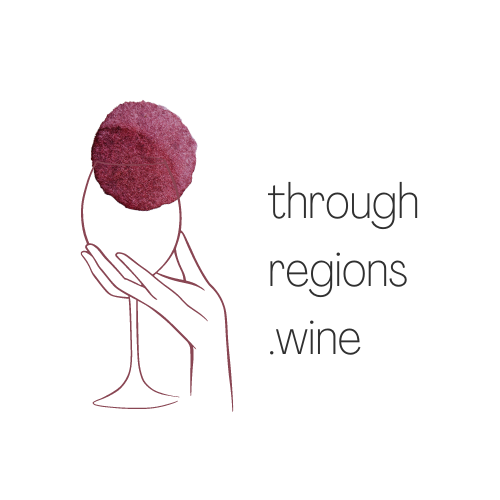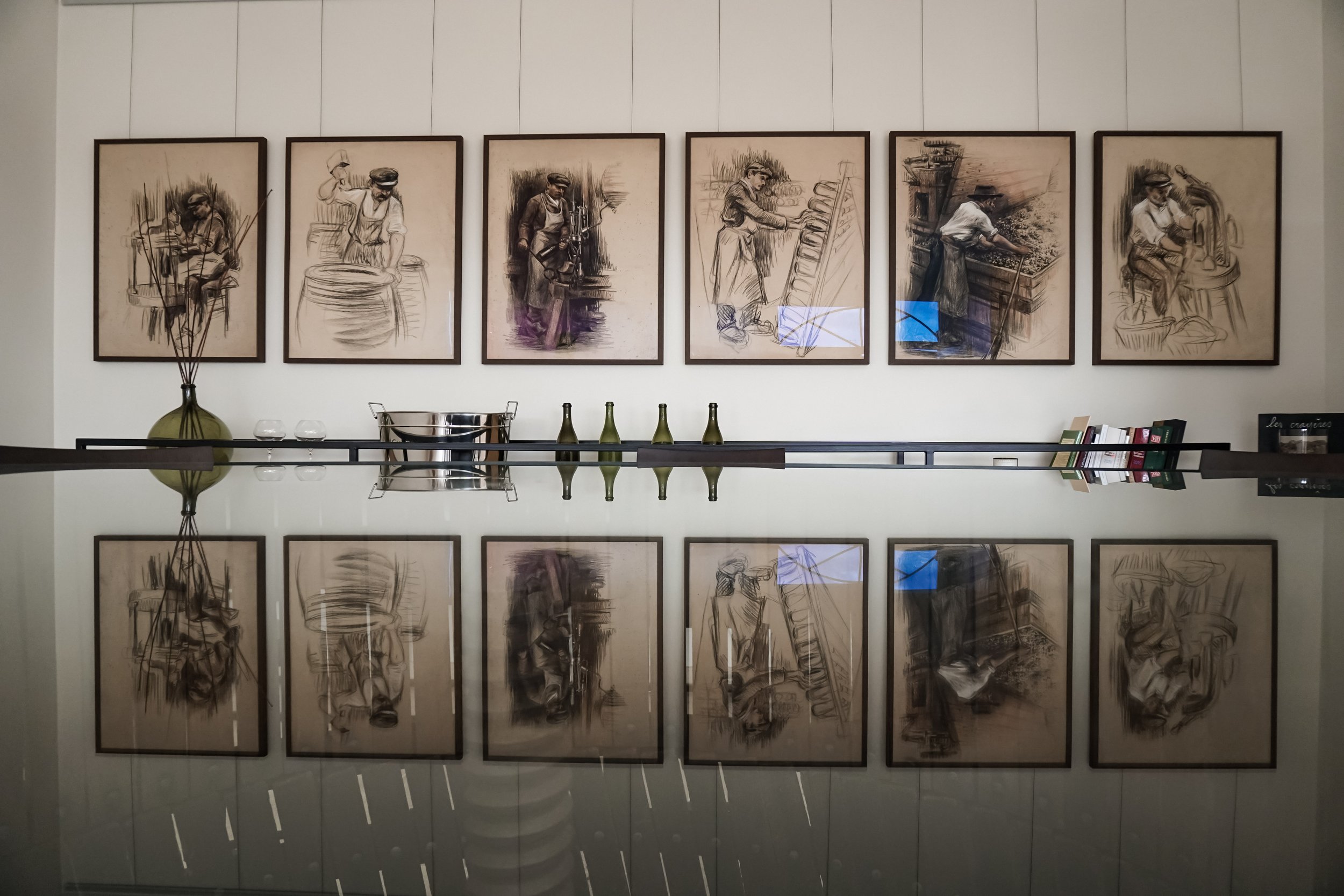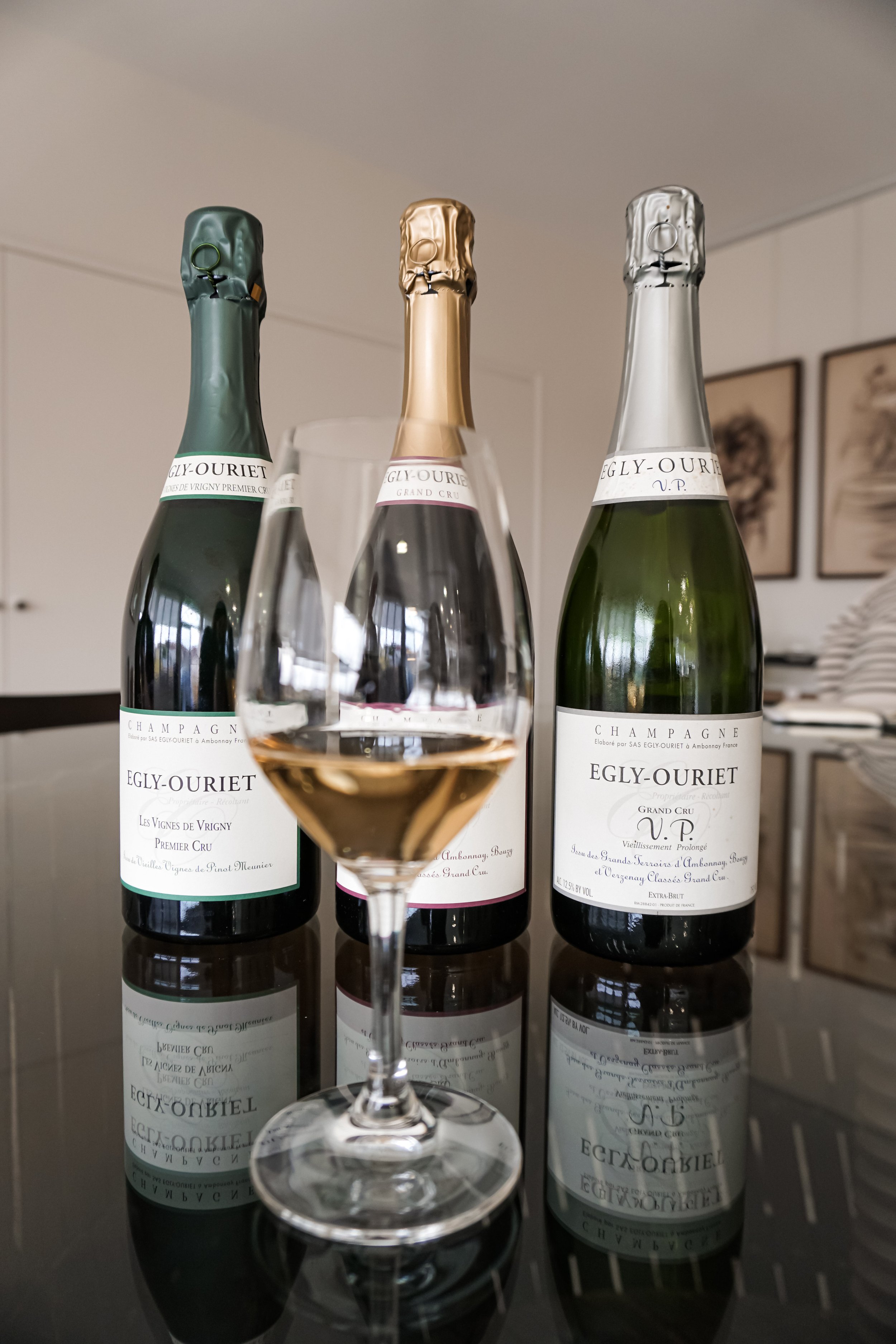Champagne. Egly-Ouriet
Egly-Ouriet is considered one of the iconic Champagne producers. It is headed by the charismatic Francis Egly, who is cited alongside Anselm Selosse as one of the most influential figures in the grower Champagne movement. Egly's wines are known for the rich Pinot Noir style typical of Ambonnay, made from later harvested, thus more ripe grapes, and aged longer than other wines from the region. Last year I had the pleasure of receiving an invitation from Clémence Egly, Francis' daughter, to visit their famous Grand Cru Ambonnay vineyard in Montagne de Reims.
Clémence Egly at the Egly-Ouriet cellar in Ambonnay, Montagne de Reims, Champagne, France.
The Egly-Ouriet winery is one of the best-known Champagne producers, but it hasn't been in the business all that long. The winery was founded in 1930, but by the time Francis Egly took over from his father Michel in 1982, most of the grapes had been sold to negociants. Francis, who is the fourth generation at the winery, immediately decided to start bottling at the estate. Today, Clémence Egly works alongside her brother Charles and father, and all the wine is vinified in Ambonnay.
Egly-Ouriet has 17 hectares of plantings, most of which are Grand Cru plots in Ambonnay, Bouzy and Verzenay, planted mainly with Pinot Noir (about 70%) with a small amount of Chardonnay (about 30%). The exception is a plot of old Pinot Meunier vines in Vrigny. The average age of the vines is about 40 years, but some were planted already in 1947. The average yield is not very high at around 8,000 kilograms per hectare. The Egly-Ouriet vineyard typically harvests grapes later than other vineyards looking for a potential alcohol content of about 11%, and thus greater fruit ripeness. The winery uses only cuvée from the first pressing for its champagne.
Although the vineyards are not certified, they are farmed organically. Egly-Ouriet's philosophy is centered on working in the vineyard, and the soils have not been worked with machines for 20 years. However, like Anselme Selosse, Francis Egly does not want to be dogmatic about winemaking.
Egly-Ouriet is among several Champagne producers who have been working differently for several decades and who have joined forces under the name Trait-d-union. The group also includes Domaine Jacques Selosse, Larmandier Bernier, Champagne Roger Coulon, Champagne Jacques Prevost and Domaine Jacquesson - six friends, Champagne producers and pioneers of Champagne de Terroir. Trait-d'Union in French means a hyphen (-) that joins two words together. Individual words retain their meaning, but the hyphen combines them with other words into a new phrase. The Trait-d'Union group chose the name for this very reason. They are individual producers who share a respect for their land and a focus on quality.
During my visit to the Champagne region, I had the opportunity to visit four of the six members of the group; coverage of my second visit to Domaine Jacques Selosse, Larmandier Bernier and Domaine Jacquesson will be posted on the blog soon. I was very impressed with the quality and uniqueness of their champagnes, which is probably related to the strong personality of each winemaker and the fact that they all focus on quality, terroir and biodiversity of the soil.
Map of the Champagne region, France. Source: https://winefolly.com/wines/champagne/
When it comes to winemaking, the use of barrel is very important in Francis' philosophy, as it enhances structure, allows for better expression of terroir and increases aging potential. For pressing, he uses traditional Coquard presses with a capacity of 4,000 kg of grapes. The Egly-Ouriet winery uses "magic barrels" pièce from Dominique Laurent of Burgundy, which are considered among the best in the world. Barrels are used for a maximum of six years. Les Prémices and Les Vignes de Vrigny are two labels that are produced exclusively in stainless steel vats. Egly-Ouriet's total production is about 140-150,000 bottles per year.
At the Egly-Ouriet winery, all cuvées are matured on the lees in the bottle, after a second fermentation, for at least 36 months before bottling. The longest maturation is Vieillissement Prolongé (V.P.), which means "prolonged aging," which spends 7 years on the lees, and vintage champagnes as long as 9 years. Remuage, which is the turning of bottles upside down after secondary fermentation is complete so that the sediment concentrates in the neck and settles on the cork, is done with gyro palettes. Fermentation is spontaneous, without clarification or filtration, and MLF is not blocked or supported. Cellars are temperature controlled, allowing even less sulfur to be added to the wine. Dosage is kept low, usually up to 5 grams per liter, and all plots are vinified separately. The cellar is very impressive, both bright and spacious to accommodate all the barrels.
In addition to Champagne, Egly-Ouriet also produces some of the best-known Coteaux Champenois, which are dry red wines made from the Pinot Noir grapes. Coteaux Champenois is the Appellation d'Origine Contrôlée (AOC) in Champagne, which covers the same area as Champagne production, but only applies to still wines. Ambonnay was historically one of the few villages in the Champagne region that was famous for still wines before the "Champagne method" became widespread. Egly-Ouriet is undoubtedly one of the largest Pinot Noir producers in the region.
Coteaux Champenois from Egly-Ouriet comes from an old vineyard more than 60 years old, located in a lieu-dit, or parcel called "Les Crayères" in the Grand Cru village of Ambonnay in the heart of the Montagne de Reims. This vineyard is located in a slight hollow that forms a kind of amphitheater, which, combined with the age of the vines and the low yields, makes this wine unique. Vinification with maturation in oak barrel for about 22 months precedes hand bottling directly from the barrel, without any filtration. This is a remarkable red wine with the potential and longevity comparable to the red Côte d'Or Grand Cru, and recently won in a blind tasting against the wines of Armand Rousseau, a well-known producer from Burgundy.
So far, climate change has been a blessing for the Champagne region. Clémence, when asked about its impact on the region's wine production, said that now it works in their favor because further supports the ripening of the grapes. Only twenty or thirty years ago, there were sometimes very difficult years in which it was a challenge to achieve good grape ripeness, but now it is easier. One day it may take a turn for the worse if the climate becomes too hot, but for now it eliminates the problems known from the worst vintages, such as 1972, 1977 and 1984. The 2022 harvest was easy for Egly-Ouriet, starting on September 1 and finishing on September 15, and with no phenolic maturity problems and little disease pressure, they expect a great vintage!
One problem with climate change is that earlier harvest dates mean higher temperatures. If grapes arrive in the vineyard at high temperatures it can lead to a rapid onset of fermentation and a potential loss of nuanced floral or fruity notes. Wineries are increasingly installing plates that lower the temperature of the juice by 10 degrees Celsius. This allows full control over the start of fermentation and then the rate at which it continues. With so much fruit often occurring at once, this is a huge convenience.
I had the pleasure of tasting the following labels:
Egly-Ouriet Les Vignes de Vrigny (100% Pinot Meunier, NV, base vintage 2018, minimum 3 years aging on lees before release, dosage 2g/l, extra brut)
The originality of this cuvèe lies in the fact that it comes exclusively from old Pinot Meunier vineyards, which are over 40 years. The vineyards are located in Vrigny and are classified as Premier Cru. The low yields, old vines and ripe fruit make this one of the most intense and multi-layered wines based solely on this varietal. Vinification takes place in steel vats, and the champagne is aged for 36 months to allow the wine to achieve its complexity, greater aging potential and better expression of terroir. On the palette it captivates with expressive notes of red fruit, white peach, orchard fruit, apple blossom and wet stones. At the same time, it shows exceptional freshness and minerality, with a slightly salty finish.
Egly-Ouriet Grand Cru Brut (70% Pinot Noir and 30% Chardonnay, dosage 2 g/l)
This Champagne was made from selected Ambonnay grapes, was partially vinified in barrels (20%) and aged for 54 months, giving it an impressive density and length of finish. It is rich and full-bodied, while maintaining a pronounced acidity. You'll feel notes of red fruits on the palette, with cranberry and red orange dominating the nose. It perfectly captures the producer's style.
Egly-Ouriet Grand Cru Extra Brut V.P. (Vieillissement Prolongé) (70% Pinot Noir and 30% Chardonnay, base vintage 2014, dosage 3g/l)
This is the same wine as the Grand Cru, but with extended aging on the lees, totaling 7 years. Red fruit blends harmoniously with chalky minerality, well-structured body and light brioche notes.
Egly-Ouriet Blanc de Noirs Grand Cru Brut "Les Crayères" Vieilles Vignes (100% Pinot Noir)
This wine comes from the oldest Pinot Noir vines of 1947 and the chalky "Crayères" vineyard, which is considered one of the best lieu-dits for Pinot. It was aged for 6 years on its lees, but the expressive fruit aromas do not allow the flavors of autolysis to dominate the palette. The wine is distinguished by red, ripe fruit with spicy and mineral notes and the best-built body of all four wines. It's definitely worth aging for at least five more years, but it already captivated me last year with its creamy texture and long finish.
Egly-Ouriet wines are intense and well-structured, which is exactly what you would expect from champagnes based primarily on Pinot Noir. Even from the entry level, the wines impress with their unique profile, balanced acidity and chalky minerality reflecting the terroir. They are definitively among the most sought-after and captivating bottles to be found in all of the Champagne region. They age gracefully and should rest a few years before opening. Their uniqueness was even crowned with a perfect score of 100 points by renowned wine critic Robert Parker in his Wine Advocate magazine for the 2008 vintage Champagne.







